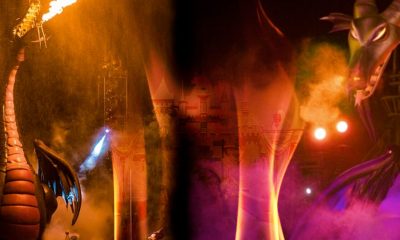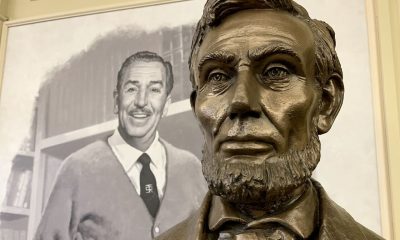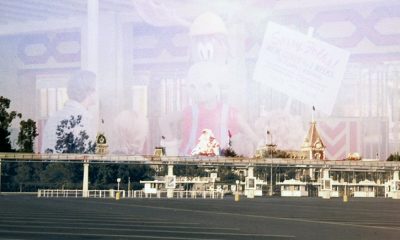Film & Movies
“Khrushchev at Disneyland” – The Film Walt Disney Almost Made
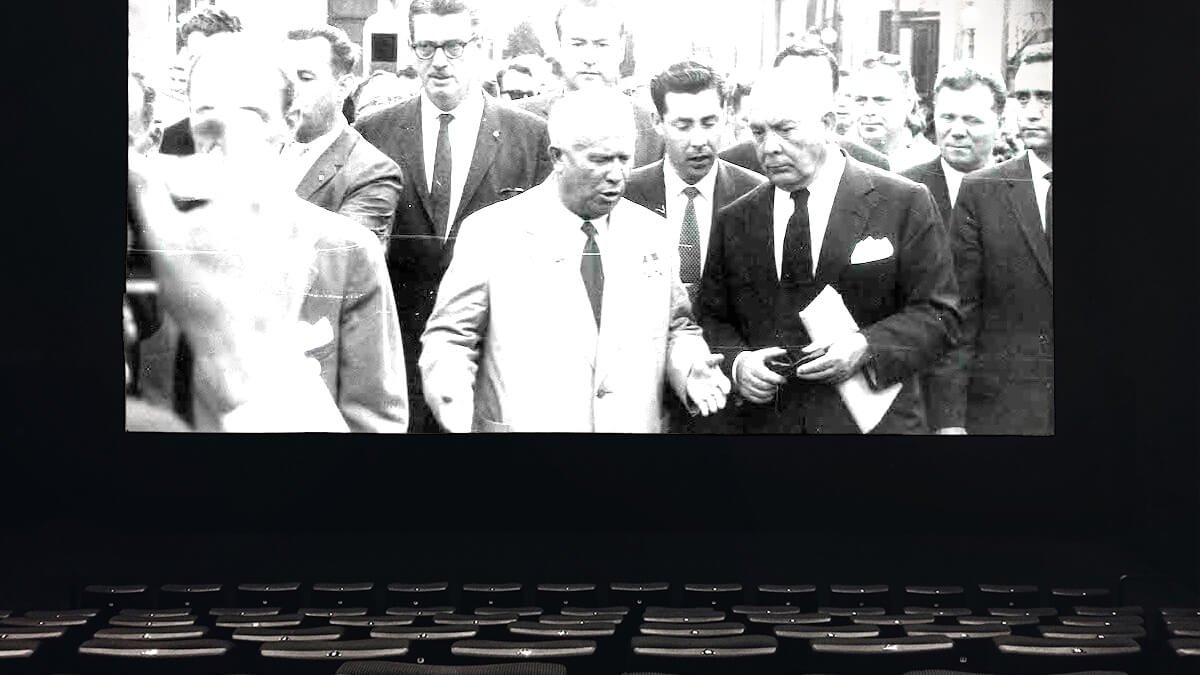
Did you ever hear about … “Khrushchev at Disneyland”?
It was back in October of last year that Disney+ revealed that they were now working on a film about the creation of Disneyland.
Given that Evan Spiliotopoulos – who crafted the screenplay for the Company’s live-action reimagining of “Beauty & the Beast” (which then went on to earn $1.26 billion at the worldwide box office back in 2017) – is reportedly writing the script for this yet-to-be-titled film, I have high hopes for this movie about the making of The Happiest Place on Earth.
After all, if we go by “Saving Mr. Banks” (i.e., That 2013 Walt Disney Pictures release about the making of “Mary Poppins,” where Emma Thompson played “Poppins” author P.L. Travers and Tom Hanks turned in a masterful performance as Walt Disney), this company-of-storytellers has already proven that it can turn its own history into entertaining motion pictures.
But that said, if The Walt Disney Company is now actively looking for moments from its past that it can possibly turn into motion pictures … Well, might I suggest a moment that Walt himself might make one hell of a movie. And that’s Soviet Premier Nikita Khrushchev’s non-visit to Disneyland.
Khrushchev’s US Visit (1959)
I don’t know how many of you are familiar with the details surrounding this incident. Which occurred during Khrushchev’s 11-day trip to the US in September 1959. The Soviet Premier and his entourage arrived in Washington D.C. and — after making a brief stop at the UN in New York City — flew out to LA … And that’s when all the trouble started.
The Los Angeles leg of Nikita’s nationwide tour really did get off to an awful start. By that I mean: As the Premier’s motorcade sped away from LAX, the limousines were actually pelted with tomatoes.
Then Khrushchev was taken to 20th Century Fox, where he and his family were supposed to be feted at a luncheon that featured hundreds of Hollywood’s top stars. Bob Hope, Frank Sinatra, Marilyn Monroe, Shirley MacLaine, David Niven and Maurice Chevalier were there.
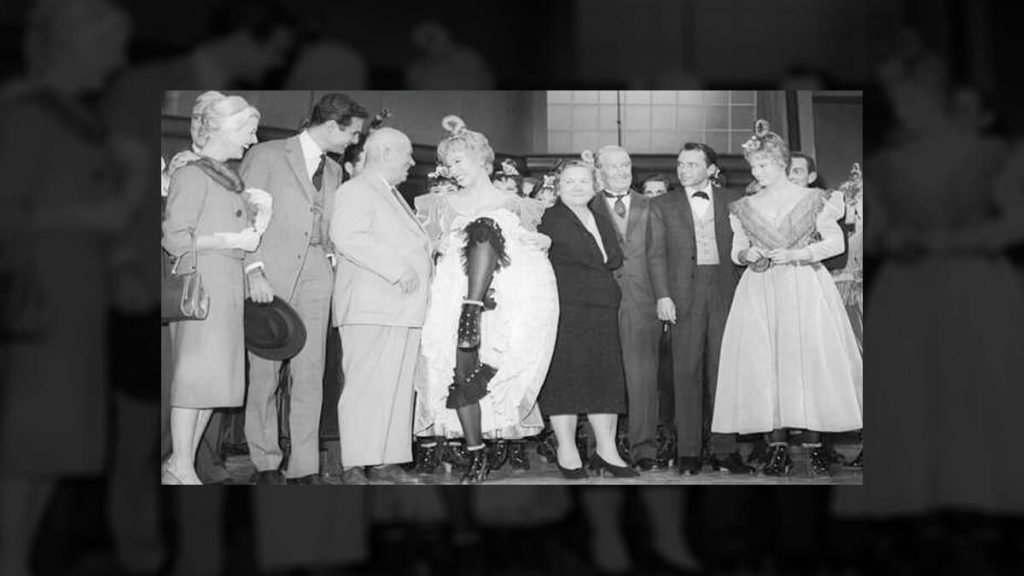
Which (you’d think) would have been enough to entertain the Soviet Premier.
Not Nikita. He stood up at this luncheon and — in front of the entire Hollywood press corps — had a hissy fit. Here’s an excerpt from the remarks that Khrushchev made that afternoon:
We have come to this town where lives the cream of American art. And just imagine (that) I, a Premier, a Soviet representative, when I came here to this city, I was given a plan. A program of what I was to be shown and whom I was to meet here.
But just now I was told that I could not go to Disneyland. I asked ‘Why not? What is it? Do you have rocket-launching pads there?’ I do not know.
And just listen – just listen to what I was told – to what reason I was told. We, which means the American authorities, can not guarantee your security if you go there.
What is it? Is there an epidemic of cholera there or something? Or have gangsters taken over the place that can destroy me? Then what must I do? Commit suicide?
This is the situation I am in. Your guest. For me, this situation is inconceivable. I can not find words to explain this to my people.
Visiting the “Happiest Place on Earth”
Truth be told, the Soviet Premier was somewhat mistaken. The original itinerary for the Los Angeles leg of his U.S. tour called for just Khrushchev’s wife and children to tour the “Happiest Place on Earth,” while Nikita was scheduled to tour a housing development out in Granada Hills. But when the Russian leader learned where his family was headed, he reportedly told his State Department handlers “Well, I wanna go to Disneyland too.”
This — unfortunately — was just impossible to pull off on such short notice. Los Angeles Police Chief William Parker immediately put the kibosh on Khrushchev’s request. Citing the difficulty of providing adequate security for the Soviet Premier and his motorcade all the way out to Anaheim.
Walt Disney Interested in Khrushchev Visiting Disneyland
Now where this gets interesting is that — somewhere along the way, as US officials were preparing for Khrushchev’s arrival in America — Walt Disney was told that the Russian Premier and his family were interested in visiting Disneyland. And Walt (of course) immediately saw this official state visit as a huge opportunity to generate some publicity for his then-four-year-old theme park.
Disneyland’s PR staff envisioned creating a photo opportunity by having Walt and Khrushchev stand on the “Submarine Voyage” ‘s loading dock as all eight of the ride’s faux subs floated by. Disney’s gag writers even provided a quip for Walt to casually toss off at this photo op. As Nikita looked out at all of those subs, Disney was supposed to say: “Well, now, Mr. Khrushchev, here’s my Disneyland submarine fleet. It’s the eighth largest submarine fleet in the world.”
Walt was — of course — disappointed when he learned that, due to security concerns, only Mrs. Khrushchev and the kids would be coming out to the Park that afternoon. So imagine Disney’s delight when this firestorm of publicity suddenly rose up when the Soviet Premier was told that he wouldn’t be allowed to go to “The Happiest Place on Earth” too.
Disneyland Trip Cancelled for Nikita Khrushchev
Because — once Nitika learned that his own trip out to Anaheim had been axed — he fell into a truly foul mood. In a fit of pique, the Soviet Premier declared that — since it wasn’t safe for him to go to Disneyland — then it wasn’t safe for his wife and children to go out to Anaheim either. So their long planned Disneyland excursion got canceled ASAP.
Immediately after the luncheon broke up, Khrushchev was taken to a nearby soundstage where the Russian Premier observed the filming of a scene from a forthcoming 20th Century Fox musical, “Can Can.” But — rather than being titillated by the sight of Juliet Prowse flashing her 19th century bloomers as she performed the film’s title number — Nikita reportedly declared the whole episode “horribly decadent.” Which embarrassed State Department officials as well as offending the Soviet Premier’s Hollywood hosts.
From there, Khrushchev’s motorcade was taken to Granada Hills, where the Russian Premier was supposed to tour model homes along Sophia Avenue. But — since Nikita was still sulking about not being allowed to go to Disneyland — he refused to even get out of his limousine.
As he pouted inside the car, Khrushchev reportedly told his State Department handlers that “… putting me in a closed car and stewing me in the sun is not the right way to guarantee my safety. This (not being allowed to go to Disneyland) development causes me bitter regret. I thought I could come here as a free man.”
To add insult to injury, four Soviet newsmen (who had been assigned to cover Khrushchev’s US trip) slipped away to Anaheim for the afternoon. They spent four happy hours touring Disneyland, then told US reporters that they believed that the Russian Premier and his family would have really enjoyed the theme park.
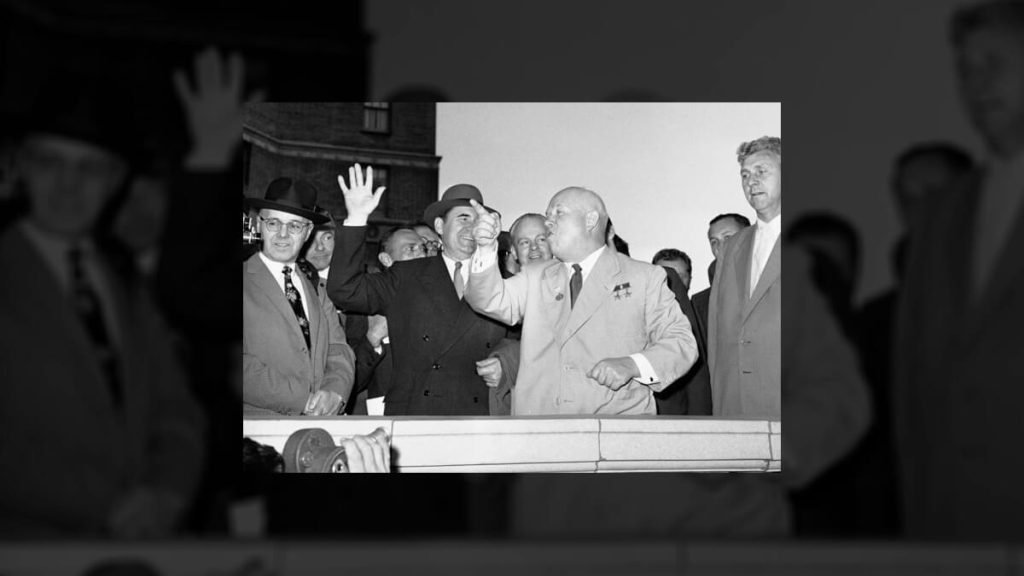
Later that evening, Khrushchev gave a speech at a Los Angeles area hotel. But there was, understandably, very little written about whatever remarks the Soviet Premier made at that long-forgotten dinner. Given that the next day’s newspapers devoted page after page to coverage of Nikita’s very public tantrum once he learned that he was not going to be allowed to visit Disneyland.
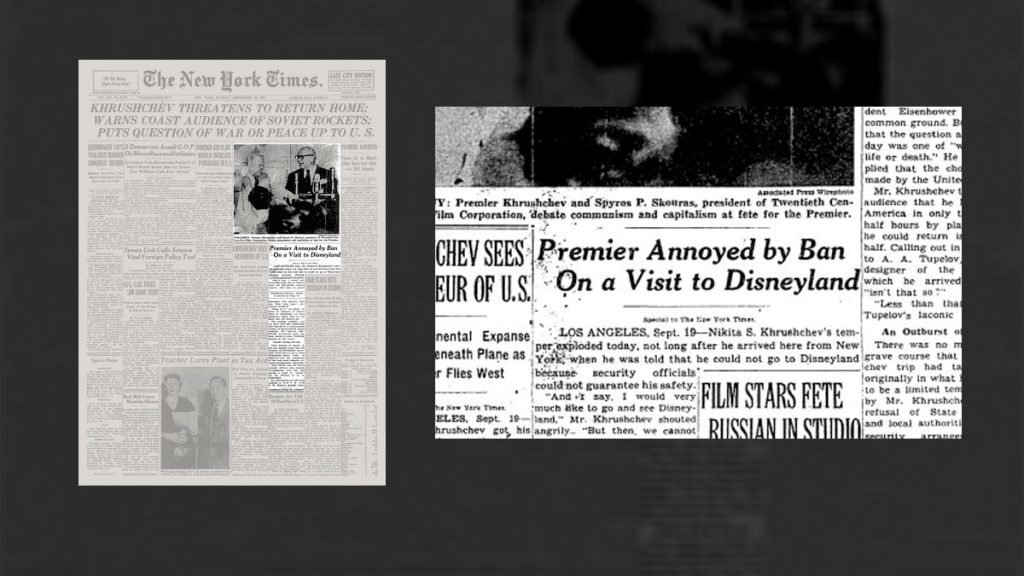
Khrushchev and his party tried to put some distance between themselves and the Disneyland debacle by quickly boarding a train and heading up to San Francisco. From there, the Russian Premier flew off to Des Moines and eventually returned to Washington D.C. Where Nikita spent a few days at Camp David with President Eisenhower talking about Cold War-related issues.
Which (you’d think) would be how history would remember the Soviet Premier’s 1959 trip to the United States. That Khrushchev & Eisenhower actually sat down and then tried to find a solution to their Germany & Berlin problem. But (picture John Belushi saying this) N-O-O-O-o-o-o. All the US press corps could talk about is how upset Nikita seemed when he had been told that he wouldn’t be allowed to visit Disneyland.
Media Covers Khrushchev’s Disneyland Denial
Within a day or so, there were political cartoons in newspapers nationwide that made fun of the Premier’s very public tantrum. Even Bob Hope eventually got into the act. As part of his annual Christmas television special, Hope stood in front of hundreds of military personnel at a U.S. Air Force base in Nome and quipped: “Here we are in America’s 49th state, Alaska. That’s halfway between Khrushchev and Disneyland.”
And of course, all this talk about how upset the Russian Premier was about not being allowed to visit “The Happiest Place on Earth” generated tons of positive publicity for Walt’s theme park. Newspapers around the world printed article after article about this amusing international incident. Even Herman Wouk (best known as the author of “The Caine Mutiny” and “The Winds of War”) chimed in: “I really don’t blame Khrushchev for jumping up and down in a rage over missing Disneyland. There are fewer things more worth seeing in the United States or indeed anywhere in the world.”
And Walt just didn’t want this fun to end. He kept looking for ways to perpetuate the story. Which is why Disney insisted that clippings highlighting the whole Khrushchev affair be included in the official Disneyland press kit for a number of years after this incident.
Movie About Khrushchev’s “Disneyland Trip”
But as the 1950s slipped into the 1960s and Khrushchev was forced from power by Leonid Brezhnev in October 1964, this story lost some of its charm. But still Walt loved to tell the tale of Nikita’s tantrum. And Disney began to wonder: might there be a way that his company could continue to capitalize on this incident? Like perhaps by maybe making a movie that would put a comic spin on the whole “Khrushchev denied access to Disneyland” incident?
So Walt turned to his very best producer, Bill Walsh (best known these days as the guy who wrote and produced “Mary Poppins,” “The Love Bug” and “Bedknobs & Broomsticks”) and told him to create a screenplay for a live-action comedy that would then be based on this infamous incident. So Walsh got together with his long-time collaborator, Don DaGradi. And eventually the two of then crafted a script or a film they wanted to call “Khrushchev at Disneyland.”
This screenplay (at least for the first 30 pages or so) pretty much follows how the real-life events played out. It recounts — in a light, breezy manner — how the Soviet leader had supposedly flown over to America to meet with President Eisenhower. But — in reality — Nikita had actually traveled all this way because what he really wanted to do was go to Disneyland.

So Khrushchev flew into Southern California, all excited that he was finally going to get his chance to visit “The Happiest Place on Earth.” Only to discover that — due to safety concerns — the State Department had canceled his trip out to Anaheim. Moviegoers were then supposed to see a slightly comic take on the Soviet Premier’s infamous tantrum at 20th Century Fox. And then …
Well, then the film morphs into your typical Walt Disney Productions live-action comedy of the 1960s. First Khrushchev is seen moping around his hotel suite in downtown Los Angeles later that evening. Then the Premier realizes that Disneyland is only 30 miles away. More importantly, that the theme park is open ’til midnight that night.
So Nikita decides that he’s going to sneak out of his hotel and somehow make his way out to Anaheim. Using a goofy disguise, he gives both his Soviet security detail as well as all of his State Department handlers the slip. Then Khrushchev somehow makes his way out to Disneyland, with all of these US & Soviet officials in hot pursuit … and hilarity ensues.
Okay. Admittedly, we’re not talking about “Lawrence of Arabia” here. Walt wasn’t really looking to make a historically accurate film based on this amusing, relatively minor international incident. Disney, Walsh, and DaGradi envisioned “Khrushchev at Disneyland” as being a film that would be very similar in tone to “That Darn Cat!” A comedy caper picture that was aimed straight at the family audience.
So — once this script was completed — how close did “Khrushchev at Disneyland” actually come to getting made? So close that Walt had already lined up an A-List actor to play the Soviet Premier. And that was Academy Award winner Peter Ustinov.
If all had gone according to plan, “Khrushchev at Disneyland” would have been Peter’s follow-up project for Disney Studios once work was completed on “Blackbeard’s Ghost.” Bill Walsh was slated to produce the picture, while the prolific Robert Stevenson would be directing.
By the fall of 1966, all of the necessary pieces were already in place. Disney Studio had a script in hand that was ready to shoot. They also had an A-List actor that was positively eager to get in front of the cameras and then do his impression of the Soviet Premier. Not only that, but Disney’s top producer was slated to ride herd on this project and the studio’s very best director would be helming this picture.
“Khrushchev at Disneyland” Movie Halts Production
So why didn’t “Khrushchev at Disneyland” get made? Well, because Walt Disney died before production could officially get underway. And given that all the studio execs that Walt had left behind were … Well … The polite term for them is “cautious corporate citizens.” The not-so-polite term is “gutless wimps.”
Anyway, these guys shied away from this project. Largely because they were concerned that there would were film fans out there who wouldn’t see the humor in “Khrushchev at Disneyland.” Their genuine fear was – because of Peter Ustinov’s sure-to-be-charming performance as Nikita Khrushchev – there were certain segments of the US population that would then accuse Walt Disney Company of corrupting America’s youth / of going soft on Communism by suggesting that – GASP ! — the Russian people were actually a lot like us. That they too like to do fun things like – say – go to Disneyland.
Of course, the real irony here is that one of the main reason that Walt really wanted his Studio to make “Kruschchev at Disneyland” was because he’d already seen that a Russians-are-people-too family comedy could succeed at the box office without controversy.
“The Russians Are Coming, The Russians Are Coming”
I’m talking – of course – about “The Russians Are Coming, The Russians Are Coming.” Which MGM had released to theaters in May of 1966 and had then gone on become the seventh highest grossing film of the year at the North American box office.
And I know for a fact that Walt was well aware of “The Russians Are Coming, The Russians Are Coming” for a couple of reasons.
- This Norman Jewison movie starred Brian Keith, who – just 5 years previous – had co-starred in Disney’s “The Parent Trap” along with Hayley Mills & Maureen O’Hara
- The year after Disney’s “Parent Trap” had been released to theaters, Jewison had directed “40 Pounds of Trouble.” Which was the first live-action film that Walt had ever allowed to be shot on location at Disneyland Park.
- For the entire Summer of 1966, “The Russians Are Coming, The Russians Are Coming” and Disney’s own “Lt. Robin Crusoe, U.S.N.” were duking it out at the North American box office. Seeing which family comedy would then go on to sell more tickets domestically. In the end, Disney came out on top. With that Dick Van Dyke movie selling $22 million worth of tickets in North America, while MGM’s Russians-are-people-too picture sold $21 million worth of tickets domestically.
This is why – when Walt made his very last trip to the Disney lot in November of 1966 – “Khrushchev at Disneyland” was very much on his mind. As far as Disney was concerned, this project was a go. Something that his Studio would start shooting in 1967 and then release to theaters the following year.
This is why Walt made a point of dropping by the set of “Blackbeard’s Ghost” that November morning. He wanted to let Peter Ustinov & Bill Walsh know how much he was looking forward to “Khrushchev at Disneyland.” And Ustinov … Well, Peter was supposedly even more excited about this back-then-soon-to-begin-shooting-movie than Walt was. Ustinov reportedly told Disney that – to insure that he look as much like the Soviet Premier as possible – this acclaimed actor was actually planning on shaving his head.
Ustinov then cracked up Walt by saying that he was thinking of basing his portrayal of Khrushchev on Peter’s mother back in England. As Disney laughed, Ustinov insisted that his Mom was a dead ringer for Nikita. “I didn’t know that your Ma was bald,” Walt replied.
Having really enjoyed his visit to the “Blackbeard’s Ghost” set, Disney then quietly excused himself and left the soundstage. Once Walt had left, Walsh and Ustinov quietly talked amongst themselves about how pale and gaunt the studio head had looked.
Of course, neither Peter or Bill knew that Walt had – just days earlier – been diagnosed with lung cancer. Or that – at this point – Disney had just weeks left to live.
And when Walt Disney died in December of 1966, “Khrushchev at Disneyland” pretty much died with him. In spite of all the preparation that had already been done on this project up until that point, Walsh and DaGradi’s script got shelved. And I’d imagine that this screenplay is now stashed away in some filing cabinet, where “Khrushchev at Disneyland” has been gathering dust for over five decades now.
Potential for “Khrushchev/Disneyland” Film
I bring up this project today … Well, for a couple of reasons.
- Disney+ has this unending appetite for new content. And wouldn’t it be cool if the Studio were to revive a project that Walt himself once wanted to make and then make that movie available to customers of the Company’s subscription streaming service.
- Given what’s going on in the Ukraine right now and how the Cold War keeps threatening to become a hot one … Well, while I am no fan of Vladimir Putin, I think that a movie which reminds us that the Russian people (NOT the Russian government, mind you. But the Russian PEOPLE) are people too … That might be a smart, hopeful message to put out in the world these days.
Making-of-Disneyland Movie on Disney+
Anyway … If the Company is looking for a follow-up for that making-of-Disneyland movie they’re prepping for Disney+ …
By the way … Interesting side note: The gentleman that Disney has tapped to direct this movie is David Gordon Green. He directed last year’s smash hit horror film, “Halloween Kills.” Which might make David seem like an odd choice to helm a film about The Happiest Place on Earth.
But then again, Gordon also executive-produces “The Righteous Gemstones.” Which is this wonderfully funny TV series about a family of televangelists who also own & operate a theme park. Which perhaps makes Mr. Green the perfect person to direct a movie about the creation of Disneyland.
Anyway … If Disney+ is looking for the perfect follow-up for their making-of-Disneyland movie, might I suggest that someone dig out a copy of “Khrushchev at Disneyland.”
More to the point, someone go ask Josh Gad if he’d be willing to shave off all those curly locks so that he could then play a certain Soviet Premier.
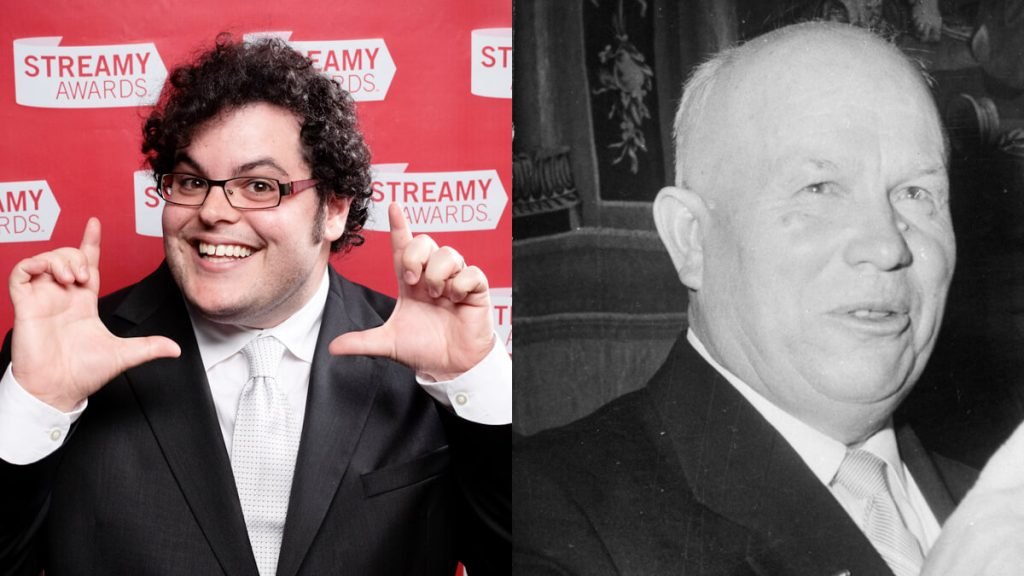
Film & Movies
How “An American Tail” Led to Disney’s “Hocus Pocus”

Over the last week, I’ve been delving into Witches Run Amok, Shannon Carlin’s oral history of the making of Disney’s Hocus Pocus. This book reveals some fascinating behind-the-scenes stories about the 1993 film that initially bombed at the box office but has since become a cult favorite, even spawning a sequel in 2022 that went on to become the most-watched release in Disney+ history.
But what really caught my eye in this 284-page hardcover wasn’t just the tales of Hocus Pocus’s unlikely rise to fame. Rather, it was the unexpected connections between Hocus Pocus and another beloved film—An American Tail. As it turns out, the two films share a curious origin story, one that begins in the mid-1980s, during the early days of the creative rebirth of Walt Disney Studios under Michael Eisner, Frank Wells, and Jeffrey Katzenberg.
The Birth of An American Tail
Let’s rewind to late 1984/early 1985, a period when Eisner, Wells, and Katzenberg were just getting settled at Disney and were on the hunt for fresh projects that would signal a new era at the studio. During this time, Katzenberg—tasked with revitalizing Disney Feature Animation—began meeting with talent across Hollywood, hoping to find a project that could breathe life into the struggling division.
One such meeting was with a 29-year-old writer and illustrator named David Kirschner. At the time, Kirschner’s biggest credit was illustrating children’s books featuring Muppets and Sesame Street characters, but he had an idea for a new project: a TV special about a mouse emigrating to America, culminating in the mouse’s arrival in New York Harbor on the same day as the dedication of the Statue of Liberty in 1886.
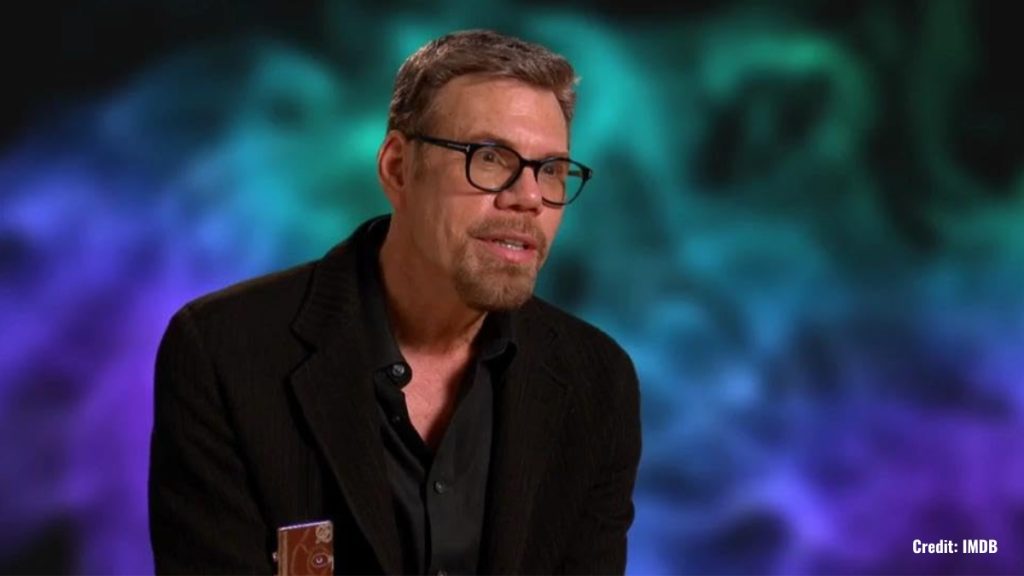
Katzenberg saw the patriotic appeal of the concept but ultimately passed on it, as he was focused on finding full-length feature projects for Disney’s animation department. Kirschner, undeterred, took his pitch elsewhere—to none other than Kathleen Kennedy, Steven Spielberg’s production partner. Kennedy was intrigued and invited Kirschner to Spielberg’s annual Fourth of July party to pitch the idea directly to the famed director.
Spielberg immediately saw the potential in Kirschner’s idea, but instead of a TV special, he envisioned a full-length animated feature film. This project would eventually become An American Tail, a tribute of sorts to Spielberg’s own grandfather, Philip Posner, who emigrated from Russia to the United States in the late 19th century. The film’s lead character, Fievel, was even named after Spielberg’s grandfather, whose Yiddish name was also Fievel.
Disney’s Loss Becomes Universal’s Gain
An American Tail went on to become a major success for Universal Pictures, which hadn’t been involved in an animated feature since the release of Pinocchio in Outer Space in 1965. Meanwhile, over at Disney, Eisner and Wells weren’t exactly thrilled that Katzenberg had let such a promising project slip through his fingers.
Not wanting to miss out on any future opportunities with Kirschner, Katzenberg quickly scheduled another meeting with him to discuss any other ideas he might have. And as fate would have it, Kirschner had just written a short story for Muppet Magazine called Halloween House, about a boy who is magically transformed into a cat by a trio of witches.
The Pitch That Sealed the Deal
Knowing Katzenberg could be a tough sell, Kirschner went all out to impress during his pitch. He requested access to the Disney lot 30 minutes early to set the stage for his presentation. When Katzenberg and the Disney development team walked into the conference room, they were greeted by a table covered in candy corn, a cauldron of dry ice fog, and a broom, mop, and vacuum cleaner suspended from the ceiling as if they were flying—evoking the magical world of Halloween House.
Katzenberg was reportedly unimpressed by the theatrical setup, muttering, “Oy, show-and-tell time” as he took his seat. But Kirschner knew exactly how to grab his attention. He started his pitch with the fact that Halloween was a billion-dollar business—a figure that made Katzenberg sit up and take notice. He listened attentively to Kirschner’s pitch, and by the time the meeting was over, Katzenberg was convinced. Halloween House would become Hocus Pocus, and Disney had its next big Halloween film.
A Bit of Hollywood Drama
Interestingly, Kirschner’s success with Hocus Pocus didn’t sit well with his old collaborators. About a year after the film’s release, Kirschner ran into Kathleen Kennedy at an Amblin holiday party, and she wasted no time in expressing her disappointment. According to Kirschner, Kennedy said, “You really hurt Steven.” When Kirschner asked how, she explained that Spielberg and Kennedy had given him his big break with An American Tail, but when he came up with the idea for his next film, he brought it to Disney rather than to them.
Hollywood can be a place where loyalty is valued—or, at least, perceived loyalty. At the same time, this was happening just as Katzenberg was leaving Disney and partnering with Spielberg and David Geffen to launch DreamWorks SKG, which only added to the tension. Loyalty, as Kirschner found out, can be an abstract concept in the entertainment industry.
A Halloween Favorite is Born
Despite its rocky start at the box office in 1993, Hocus Pocus has gone on to become a beloved part of Halloween pop culture. And, as Carlin’s book details, its success helped pave the way for more Disney Halloween-themed projects in the years that followed.
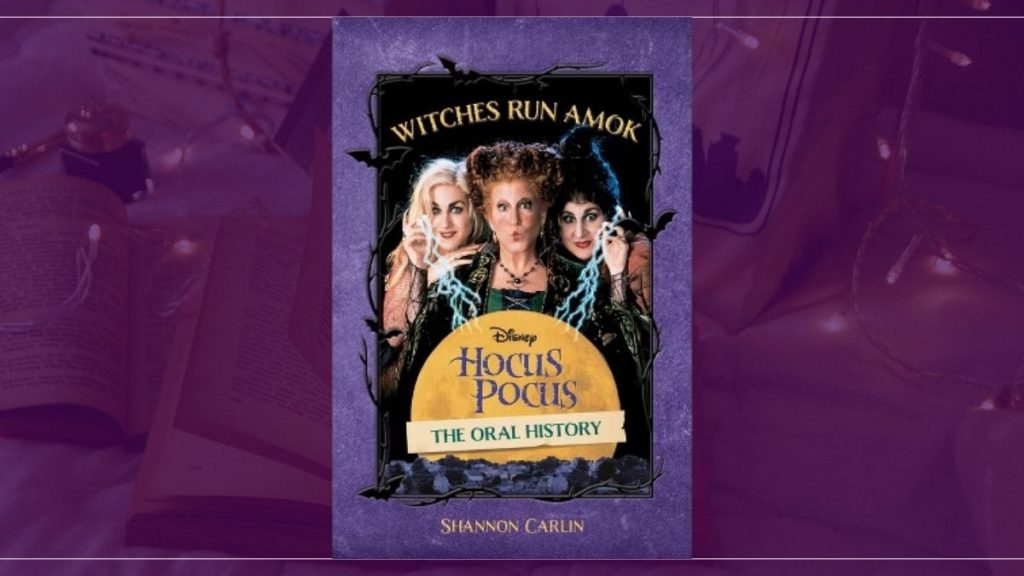
As for why Hocus Pocus was released in July of 1993 instead of during Halloween? That’s a story for another time, but it has something to do with another Halloween-themed project Disney was working on that year—Tim Burton’s The Nightmare Before Christmas—and Katzenberg finding himself in the awkward position of having to choose between keeping Bette Midler or Tim Burton happy.
For more behind-the-scenes stories about Hocus Pocus and other Disney films, be sure to check out Witches Run Amok by Shannon Carlin. It’s a fascinating read for any Disney fan!
And if you love hearing these kinds of behind-the-scenes stories about animation and film history, be sure to check out Fine Tooning with Drew Taylor, where Drew and I dive deep into all things movies, animation, and the creative decisions that shape the films we love. You can find us on your favorite podcast platforms or right here on JimHillMedia.com.
Film & Movies
How Disney’s “Bambi” led to the creation of Smokey Bear

When people talk about Disney’s “Bambi,” the scene that they typically cite as being the one from this 1942 film which then scarred them for life is – of course – the moment in this movie where Bambi’s mother gets shot by hunters.
Which is kind of ironic. Given that – if you watch this animated feature today – you’ll see that a lot of this ruined-my-childhood scene actually happens off-camera. I mean, you hear the rifle shot that takes down Bambi’s Mom. But you don’t actually see that Mama Deer get clipped.
Now for the scariest part of that movie that you actually see on-camera … Hands down, that has to be the forest fire sequence in “Bambi.” As the grown-up Bambi & his bride, Faline, desperately race through those woods, trying to find a path to safety as literally everything around them is ablaze … That sequence is literally nightmare fuel.
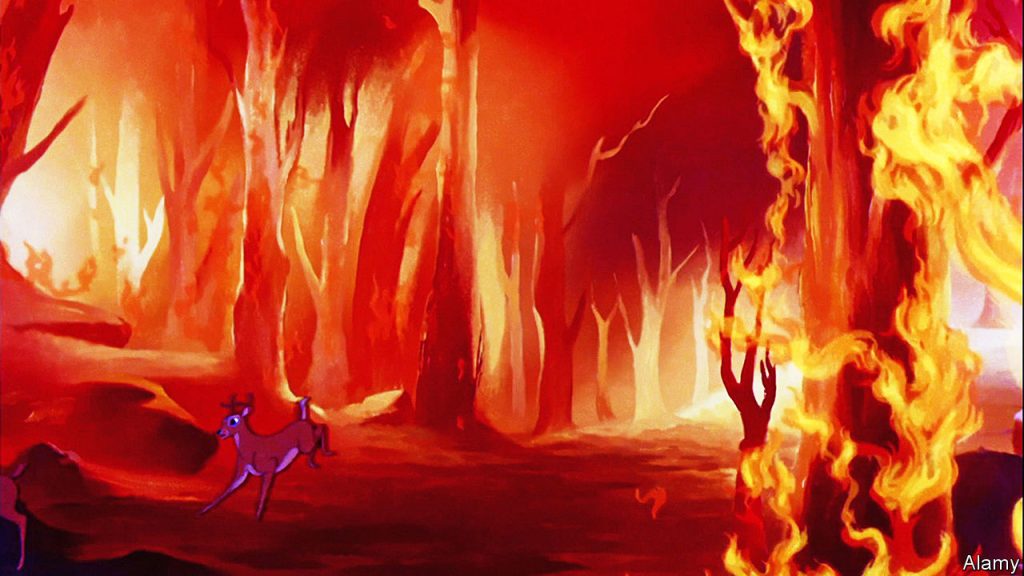
Mind you, the artists at Walt Disney Animation Studios had lots of inspiration for the forest fire sequence in “Bambi.” You see, in a typical year, the United States experiences – due to either natural phenomenon like lightning strikes or human carelessness – 100 forest fires. Whereas in 1940 (i.e., the year that Disney Studios began working in earnest of a movie version of Felix Salten’s best-selling movie), America found itself battling a record 360 forest fires.
Which greatly concerned the U.S. Forest Service. But not for the reason you might think.
Protecting the Forest for World War II
I mean, yes. Sure. Officials over in the Agricultural Department (That’s the arm of the U.S. government that manages the Forest Service) were obviously concerned about the impact that this record number of forest fires in 1940 had had on citizens. Not to mention all of the wildlife habitat that was now lost.
But to be honest, what really concerned government officials was those hundreds of thousands of acres of raw timber that had been consumed by these blazes. You see, by 1940, the world was on the cusp of the next world war. A conflict that the U.S. would inevitably be pulled into. And all that now-lost timber? It could have been used to fuel the U.S. war machine.
So with this in mind (and U.S. government officials now seeing an urgent need to preserve & protect this precious resource) … Which is why – in 1942 (just a few months after the Japanese bombed Pearl Harbor) – the U.S. Forest Service rolls out its first-ever forest fire prevention program.
Which – given that this was the early days of World War II – the slogan that the U.S. Forest Service initially chose for its forest fire prevention program is very in that era’s we’re-all-in-this-together / so-let’s-do-what-we-can-to-help-America’s war-effort esthetic – made a direct appeal to all those folks who were taking part in scrap metal drives: “Forest Defense is National Defense.”

And the poster that the U.S. Forest Service had created to support this campaign? … Well, it was well-meaning as well. It was done in the WPA style and showed men out in the forest, wielding shovels to ditch a ditch. They were trying to construct a fire break, which would then supposedly slow the forest fire that was directly behind them.
But the downside was … That “Forest Defense is National Defense” slogan – along with that poster which the U.S. Forest Service had created to support their new forest fire prevention program didn’t exactly capture America’s attention.
I mean, it was the War Years after all. A lot was going in the country at that time. But long story short: the U.S. Forest Service’s first attempt at launching a successful forest fire prevention program sank without a trace.
So what do you do in a situation like this? You regroup. You try something different.
Disney & Bambi to the Rescue
And within the U.S. government, the thinking now was “Well, what if we got a celebrity to serve as the spokesman for our new forest fire prevention program? Maybe that would then grab the public’s attention.”
The only problem was … Well, again, these are the War Years. And a lot of that era’s A-listers (people like Jimmy Stewart, Clark Gable, even Mel Brooks) had already enlisted. So there weren’t really a lot of big-name celebrities to choose from.
But then some enterprising official at the U.S. Forest Service came up with an interesting idea. He supposedly said “Hey, have you seen that new Disney movie? You know, the one with the deer? That movie has a forest fire in it. Maybe we should go talk with Walt Disney? Maybe he has some ideas about how we can better capture the public’s attention when it comes to our new forest fire prevention program?”
And it turns Walt did have an idea. Which was to use this government initiative as a way to cross-promote Disney Studio’s latest full-length animated feature, “Bambi.” Which been first released to theaters in August of 1942.
So Walt had artists at Disney Studio work up a poster that featured the grown-up versions of Bambi the Deer, Thumper the Rabbit & Flower the Skunk. As this trio stood in some tall grasses, they looked imploring out at whoever was standing in front of this poster. Above them was a piece of text that read “Please Mister, Don’t Be Careless.” And below these three cartoon characters was an additional line that read “Prevent Forest Fires. Greater Danger Than Ever!”
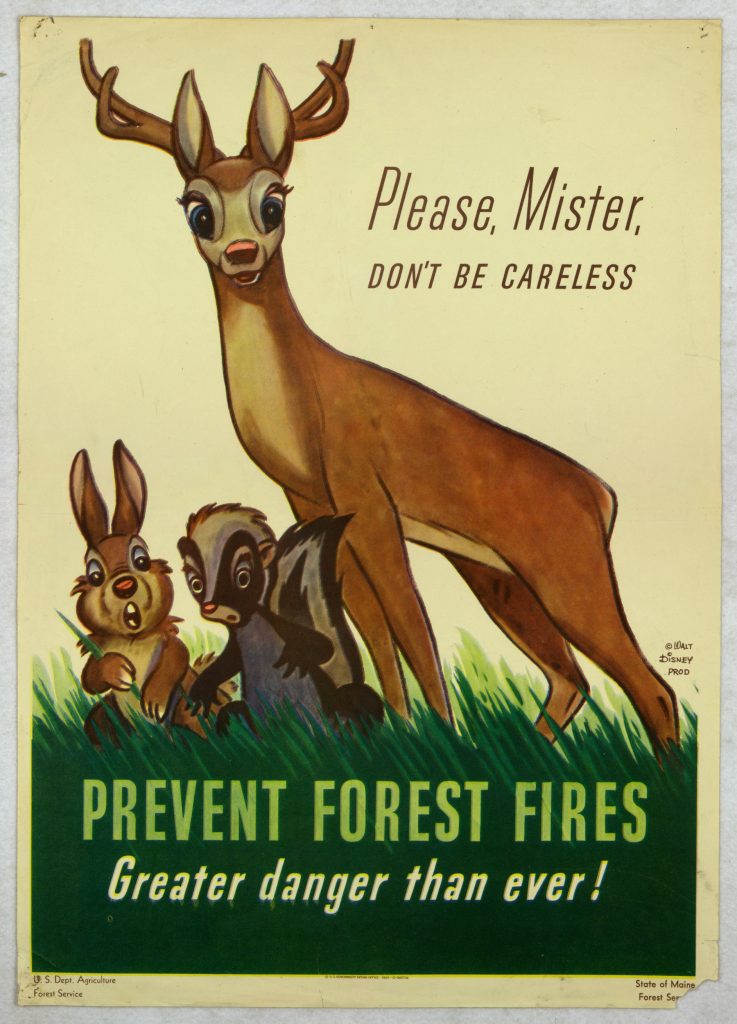
According to folks I’ve spoken with at Disney’s Corporate Archives, this “Bambi” -based promotional campaign for the U.S. Forest Service’s forest fire prevention campaign was a huge success. So much so that – as 1943 drew to a close – this division of the Department of Agriculture reportedly reached out to Walt to see if he’d be willing to let the U.S. Forest Service continue to use these cartoon characters to help raise the public’s awareness of fire safety.
Walt – for reasons known only to Mr. Disney – declined. Some have suggested that — because “Bambi” had actually lost money during its initial theatrical release in North America – that Walt was now looking to put that project behind him. And if there were posters plastered all over the place that then used the “Bambi” characters that then promoted the U.S.’s forest fire prevention efforts … Well, it would then be far harder for Mr. Disney to put this particular animated feature in the rear view mirror.
Introducing Smokey Bear
Long story short: Walt said “No” when it came to reusing the “Bambi” characters to promote the U.S. Forest Service’s forest fire prevention program. But given how successful the previous cartoon-based promotional campaign had been … Well, some enterprising employee at the Department of Agriculture reportedly said “Why don’t we come up with a cartoon character of our own?”
So – for the Summer of 1944 – the U.S. Forest Service (with the help of the Ad Council and the National Association of State Foresters) came up with a character to help promote the prevention of forest fires. And his name is Smokey Bear.
Now a lot of thought had gone into Smokey’s creation. Right from the get-go, it was decided that he would be an American black bear (NOT a brown bear or a grizzly). To make this character seem approachable, Smokey was outfitted with a ranger’s hat. He also wore a pair of blue jeans & carried a bucket.
As for his debut poster, Smokey was depicted as pouring water over a still-smoldering campfire. And below this cartoon character was printed Smokey’s initial catchphrase. Which was “Care will prevent 9 out of 10 forest fires!”
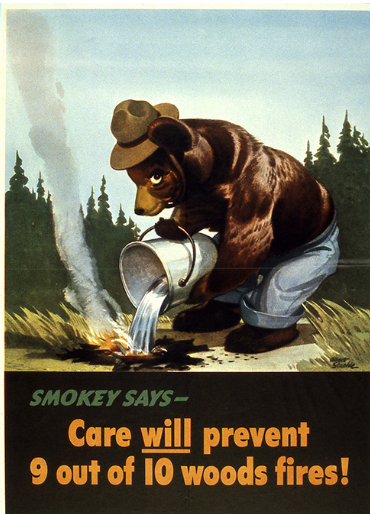
Which makes me think that this slogan was written by the very advertising executive who wrote “Four out of five dentists recommend sugarless gum for their patients who chew gum.”
Anyway … By the Summer of 1947, Smokey got a brand-new slogan. The one that he uses even today. Which is “Only YOU can prevent forest fires.”
The Real Smokey Bear
Now where this gets interesting is – in the Summer of 1950 – there was a terrible forest fire up in the Capitan Mountains of New Mexico. And over the course of this blaze, a bear cub climbed high up into a tree to try & escape those flames.
Firefighters were finally able to rescue that cub. But he was so badly injured in that fire that he was shipped off to the National Zoo in Washington, D.C. and nursed back to health. And since this bear really couldn’t be released back in the wild at this point, he was then put on exhibit.
And what does this bear’s keepers decide to call him? You guessed it: Smokey.
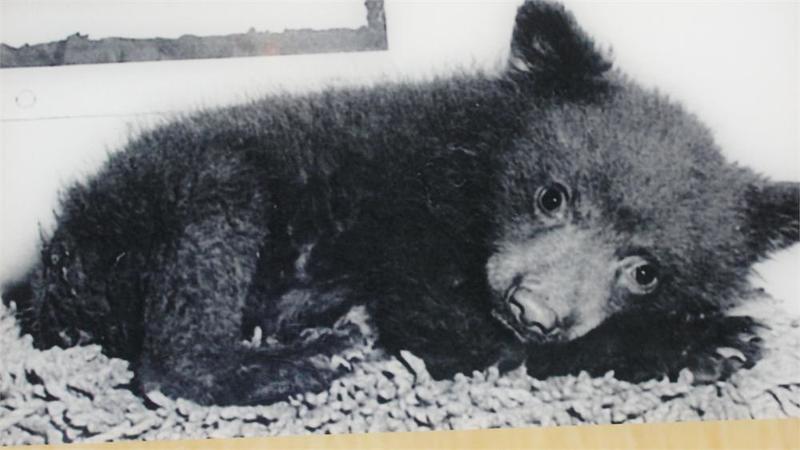
And due to all the news coverage that this orphaned bear got, he eventually became the living symbol of the U.S. Forest Service’s forest fire prevention program. Which then meant that this particular Smokey Bear got hit with a ton of fan mail. So much so that the National Zoo in Washington D.C. wound up with its own Zip Code.
“Smokey the Bear” Hit Song
And on the heels of a really-for-real Smokey Bear taking up residence in our nation’s capital, Steve Nelson & Jack Rollins decide to write a song that shined a spotlight on this fire-fightin’ bruin. Here’s the opening stanza:
With a ranger’s hat and shovel and a pair of dungarees,
You will find him in the forest always sniffin’ at the breeze,
People stop and pay attention when he tells them to beware
Because everybody knows that he’s the fire-preventin’ bear
Believe or not, even with lyrics like these, “Smokey the Bear” briefly topped the Country charts in the Summer of 1950. Thanks to a version of this song that was recorded by Gene Autry, the Singing Cowboy.
By the way, it was this song that started all of the confusion in regards to Smokey Bear’s now. You see, Nelson & Rollins – because they need the lyrics of their song to scan properly – opted to call this fire-fightin’-bruin Smokey THE Bear. Rather than Smokey Bear. Which has been this cartoon character’s official name since the U.S. Forest Service first introduced him back in 1944.
“The Ballad of Smokey the Bear”
Further complicating this issue was “The Ballad of Smokey the Bear,” which was a stop-motion animated special that debuted on NBC in late November of 1966. Produced by Rankin-Bass as a follow-up to their hugely popular “Rudolph the Red-Nosed Reindeer” (which premiered on the Peacock Network in December of 1964) … This hour-long TV show also put a “THE” in the middle of Smokey Bear’s name because the folks at Rankin-Bass thought his name sounded better that way.
And speaking of animation … Disney’s “Bambi” made a brief return to the promotional campaign for the U.S. Forest Service’s forest fire prevention program in the late 1980s. This was because the Company’s home entertainment division had decided to release this full-length animated feature on VHS.
What’s kind of interesting, though, is the language used on the “Bambi” poster is a wee different than the language that’s used on Smokey’s poster. It reads “Protect Our Forest Friends. Only You Can Prevent Wildfires.” NOT “Forest Fires.”
Anyway, that’s how Disney’s “Bambi” led to the creation of Smokey Bear. Thanks for bearin’ with me as I clawed my way through this grizzly tale.
Film & Movies
“Indiana Jones and the Search for Indiana Jones”
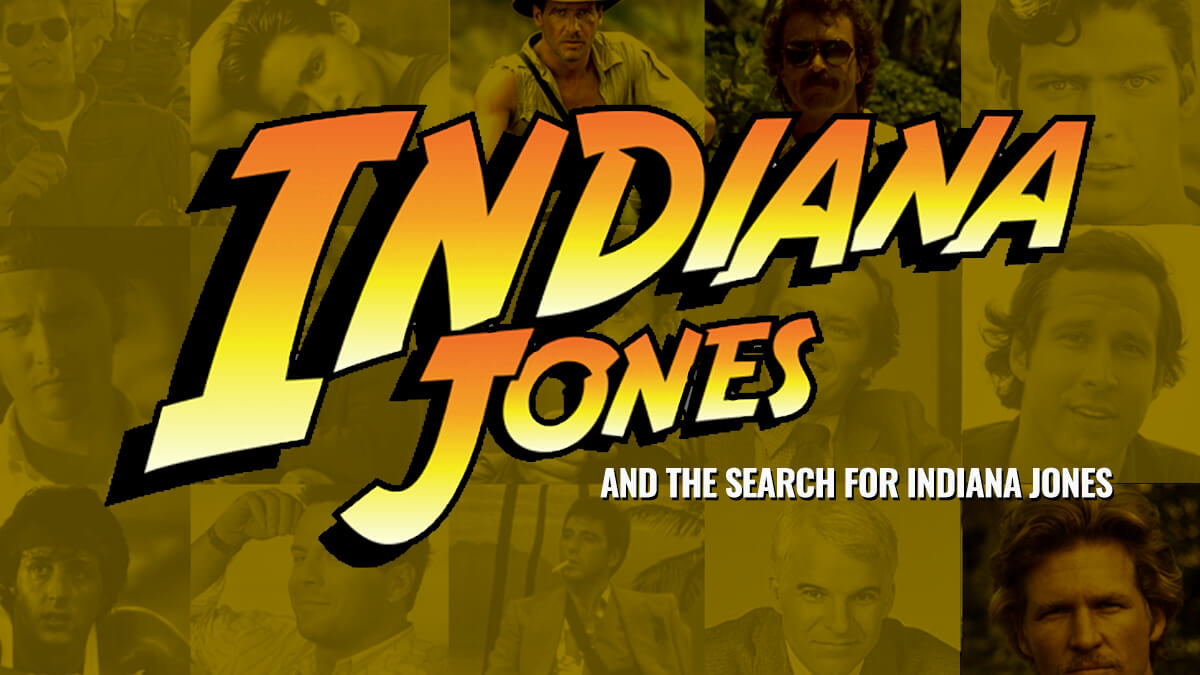
News came late last week that NBC was cancelling the “Magnum PI” remake. This series (which obviously took its inspiration from the Tom Selleck show that originally debuted on CBS back in December of 1980 and then went on run on that network for 8 seasons. With its final episode airing on May 8, 1988).
Anyway … Over 30 years later, CBS decided to remake “Magnum.” This version of the action drama debuted on September 24, 2018 and ran for four seasons before then being cancelled. NBC picked up the “Magnum” remake where it ran for one more season before word came down on June 23rd that this action drama was being cancelled yet again.
FYI: The second half of Season 5 of “Magnum” (10 episodes) has yet to air on NBC. It will be interesting to see when that final set of shows / the series finale gets scheduled.
This all comes to mind this week – out ahead of the theatrical release of “Indiana Jones and the Dial of Destiny” because … Well, if CBS execs had been a bit more flexible back in 1980, the star of the original version of “Magnum PI” (Tom Selleck) would have played the lead in “Raiders of the Lost Ark.” Which was released to theaters back on June 12, 1981.
That’s the part of the Indiana Jones story that the folks at Lucasfilm often opt to skim over.
That Harrison Ford wasn’t George Lucas’ first choice to play Doctor Jones.
Auditions for Indiana Jones – Harrison’s Not on the List
Mind you, Steven Spielberg – right from the get-go – had pushed for Ford to play this part. The way I hear it, Lucas showed Spielberg a work-in-progress cut of “The Empire Strikes Back.” And Steven was so taken with Harrison’s performance as Han Solo in that Irwin Kershner film that he immediately began pushing for Ford to be cast as Doctor Jones.
Whereas Mr. Lucas … I mean, it wasn’t that George had anything against Harrison. What with Ford’s performances first in “American Grafitti” and then in “A New Hope,” these two already had a comfortable working relationship.
But that said, Lucas was genuinely leery of … Well, the sort of creative collaboration that Martin Scorcese and Robert DeNiro. Where one actor & one director repeatedly worked together. To George’s way of thinking, that was a risky path to follow. Hitching your wagon to a single star.
Which is why – when auditions got underway for “Raiders of the Lost Ark” in 1979 — Mike Fenton basically brought in every big performer of that era to read for Dr. Jones except Harrison Ford. We’re talking:
- Steve Martin
- Chevy Chase
- Bill Murray
- Jack Nicholson
- Peter Coyote
- Nick Nolte
- Sam Elliot
- Tim Matheson
- and Harry Hamlin
Casting a Comedian for Indiana Jones
Please note that there are a lot of comedians on this list. That’s because – while “Raiders of the Lost Ark” was in development — Spielberg was directed his epic WWII comedy, “1941.” And for a while there, Steve & George were genuinely uncertain about whether the movie that they were about to make would be a sincere valentine to the movie serials of the 1930s & the 1940s or more of a spoof.
It’s worth noting here that three of the more ridiculous set pieces found in “Temple of Doom” …
- the shoot-out at Club Obi Wan in Shanghai
- Indy, Willie & Short Round surviving that plane crash by throwing an inflatable life raft out of the cargo hatch
- and that film’s mine cart chase (which was not only inspired by Disney theme park favorites the Matterhorn Bobsleds & Big Thunder Mountain Railroad but some of the sound effects that you hear in this portion of “Temple of Doom” were actually recorded after hours at Disneyland inside of these very same attractions)
… all originally supposed to be in “Raiders of the Lost Ark.” I’ve actually got a copy of the very first version of the screenplay that Lawrence Kasdan wrote for the first “Indy” movie where all three of these big action set pieces were supposed to be part of the story that “Raiders” told. And I have to tell you that this early iteration of the “Raiders” screenplay really does read more like a spoof of serials than a sincere, loving salute to this specific style of cinema.
Casting Indiana Jones – Jeff or Tom
Anyway … Back now to the casting of the male lead for “Raiders” … After seeing virtually every actor out in LA while looking for just the right performer to portray Indiana Jones, it all came down to two guys:
- Jeff Bridges
- and Tom Selleck
Jeff Bridges as Indiana Jones
Mike Fenton was heavily pushing for Jeff Bridges. Having already appeared with Clint Eastwood in 1974’s “Thunderbolt & Lightfoot” (Not to mention that “King Kong” remake from 1976), Bridges was a known quantity. But what Fenton liked especially liked about Bridges when it came to “Raiders” was … Well, at that time, Jeff was just coming off “Heaven’s Gate.”
Mind you, nowadays, because we’ve all now had the luxury of seeing the director’s cut of this Michael Cimino movie, we recognize “Heaven’s Gate” for the cinematic masterpiece that it is. But 40+ years ago, that honestly wasn’t the case. All audiences had to judge this movie by was the severely truncated version that United Artists sent out into theaters. Which – because “Heaven’s Gate” had cost $44 million to make and only sold $3.5 million of tickets – then became the textbook example of Hollywood excess.
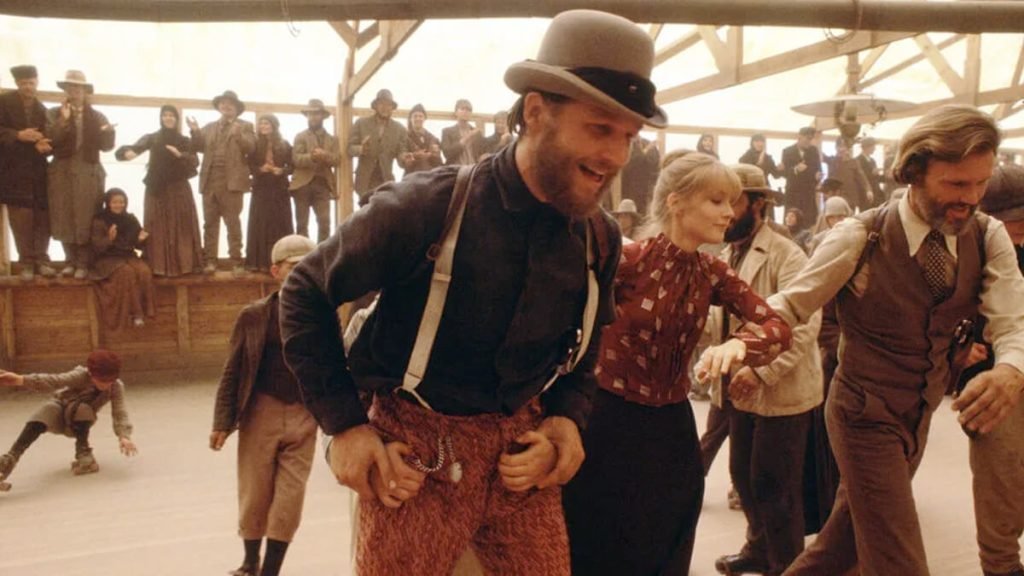
Long story short: Given that being associated with “Heaven’s Gate” had somewhat dinged Bridges’ reputation for being a marketable star (i.e., a performer that people would pay good money to see up on the big screen), Jeff was now looking to appear in something highly commercial. And the idea of playing the lead in a film directed by Steven Spielberg (the “Jaws” & “Close Encounter” guy) and produced by George Lucas (Mr. “Star Wars”) was very, very appealing at that time. Bridges was even willing to sign a contract with Spielberg & Lucas that would have then roped him into not only playing Indiana Jones in “Raider of the Lost Ark” but also to appear as this very same character in two yet-to-be-written sequels.
Better yet, because “Heaven’s Gate” had temporarily dimmed Bridges’ star status, Jeff was also willing to sign on to do the first “Indy” film for well below his usual quote. With the understanding that – should “Raiders of the Lost Ark” succeed at the box office – Bridges would then be paid far more to appear in this film’s two sequels.
That seemed like a very solid plan for “Raiders.” Landing a known movie star to play the lead in this action-adventure at a bargain price.
Ah, but standing in Mike Fenton’s way was Marcia Lucas.
Tom Selleck as Indiana Jones
Marcia Lucas, who had seen Tom Selleck’s audition for “Raiders” (And you can see it as well. Just go to Google and type in “Tom Selleck” and “Indiana Jones.” And if you dig around for a bit, you’ll then see a feature that Lucas & Spielberg shot for “Entertainment Tonight” back in 2008 [This story was done in support of the theatrical release of “Indiana Jones and the Kingdom of the Crystal Skull”]. And as part of this piece, George and Steve share Tom’s original audition for “Raiders.” And what’s genuinely fascinating about this footage is that Selleck’s scene partner is Sean Young. Who – at that time, anyway – was up for the role of Marion Ravenwood) and kept telling her husband, “You should cast this guy. He’s going to be a big star someday.”
And given that George was smart enough to regularly heed Marcia Lucas’ advice (She had made invaluable suggestions when it came to the editing of “American Graffiti” and the original “Star Wars.” Not to downplay George Lucas’ cinematic legacy, but Marcia Lucas was a world-class storyteller in and of her own right), Lucas then reached out to Spielberg and persuaded him that they should cast relative unknown Tom Selleck as Doctor Jones over the already well-known Jeff Bridges.
Now don’t feel too bad for Jeff Bridges. When he lost out on playing the lead in “Raiders of the Lost Ark,” Jeff then accepted a role in the very next, high profile, sure-to-be-commercial project that came along. Which turned out to be Disney’s very first “TRON” movie. Which was eventually released to theaters on July 9, 1982.
Back to Tom Selleck now … You have to remember that – back then – Selleck was the handsome guy who’d already shot pilots for six different shows that then hadn’t gone to series. Which was why Tom was stuck being the guest star on shows like “The Fall Guy” and “Taxi.” Whereas once word got out around town that Selleck was supposed to play the lead in a project that Spielberg was directed & Lucas was producing … Well, this is when CBS decided that they’d now take the most recent pilot that Tom had shot and then go to series with this show.
That program was – of course – the original “Magnum PI.” And it’s at this point where our story started to get complicated.
“Magnum PI” – Two Out of Three Say “Yes”
Okay. During the first season of a TV show, it’s traditionally the network – rather than the production company (which – in this case – was Glen A. Larson Productions. The company behind the original versions of “Battlestar Galactica” & “Knight Rider”) or the studio where this series is actually being shot (which – in this case – was Universal Television) that has all the power. And in this particular case, the network execs who were pulling all the strings behind-the-scenes worked for CBS.
And when it came to the first season of “Magnum PI,” CBS had a deal with Glen A. Larson Productions and Universal Television which stated that the talent which had been contracted to appear in this new action drama would then be available for the production of at least 13 episodes with an option to shoot an additional 9 episodes (This is known in the industry as the back nine. As in: the last nine holes of a golf course).
Anyway, if you take those initial 13 episodes and then tack on the back nine, you then get 22 episodes total. Which – back in the late 1970s / early 1980s, anyway – was what a full season of a network television show typically consisted of.
Anyway … The contract that Selleck had signed with Glen A. Larson Productions, Universal Television & CBS stated that he had to be available when production of Season One of “Magnum PI” began in March of 1980. More to the point, Tom also had to be available should CBS exercise its option to air 22 episodes of this new series on that television network over the course of “Magnum PI” ‘s first season.
Which then made things complicated for George Lucas & Steven Spielberg because … Well, in order for “Raiders of the Lost Ark” to make its June 12, 1981 release date, that then meant that production of the first “Indy” movie would have to get underway no later than June 23, 1980.
But here’s the thing: Production of Season One of “Magnum PI” was scheduled to run through the first week of July of that same year (1980). So in order for Tom Selleck to play Indiana Jones in “Raiders,” he was going to need to be wrapped on production of “Magnum PI” by June 22, 1980 at the absolute latest.
So Spielberg & Lucas went to Glen A. Larsons Productions and asked if Selleck could please be sprung from his “Magnum PI” contractual obligations by June 22nd. And they said “Yes.” Then Steven & George went to Universal Television and asked executives there for their help in clearing Tom’s schedule so that he’d then be available to start work on “Raiders.” And they say “Yes” as well.
Spielberg & Lucas now go to CBS. But instead of the quick “Yeses” that they got from officials at Glen A. Larson Productions and Universal Television, it takes those suits at the Tiffany Network weeks before they then decided to say “No, they couldn’t release Tom Selleck early to go work on ‘Raiders’ “ because …
I’ve never really been able to get a straight answer here as to why CBS execs dug in their heels here. Why they flat-out refused to release Selleck early from his “Magnum PI” contractual obligation and allow him to go shoot “Raiders.”
Payback from “The Star Wars Holiday Special” Trash Talk
That said, it is worth noting that “The Star Wars Holiday Special” aired on CBS back in November of 1978. And given that – in the years that followed — Lucas wasn’t exactly shy when it came to saying how much he hated that two hour-long presentation (Or – for that matter – how George really regretted caving into the requests of CBS execs. Who had insisted that television stars long associated with the Tiffany Network – people like Art Carney, Harvey Korman & Bea Arthur – be given prominent guest starring roles in “The Star Wars Holiday Special”). And I’ve heard whispers over the years that CBS executives preventing Tom Selleck from appearing in “Raiders” could be interpreted as the Tiffany Network getting some payback for what George had said publicly about the “Star Wars Holiday Special.”
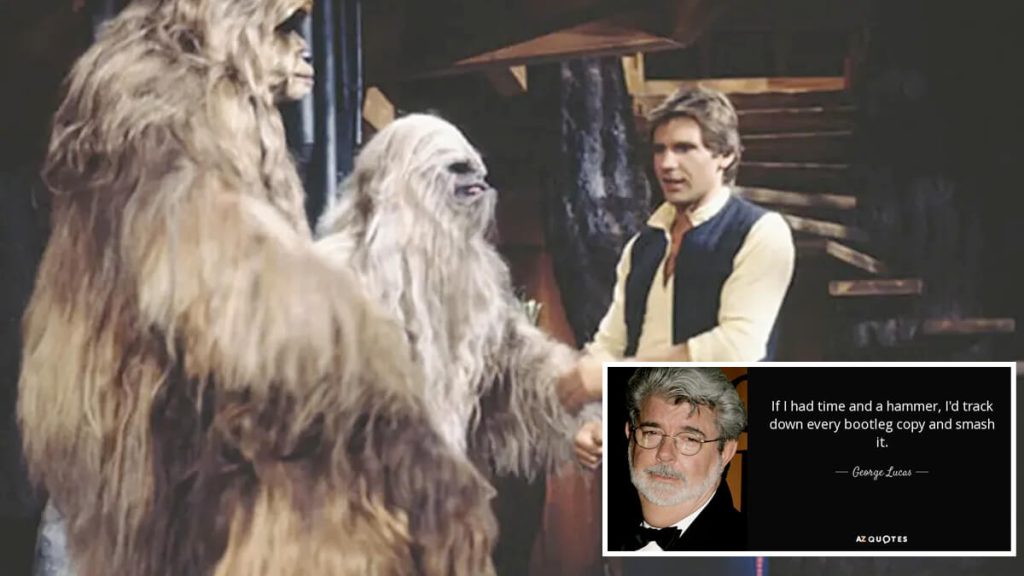
Harrison Ford Comes to Rescue “Indiana Jones”
Anyway … It’s now literally just weeks before production of “Raiders of the Lost Ark” is supposed to begin and Spielberg & Lucas have just learned that that they’ve lost their film’s star. CBS is flat-out refusing to release Tom Selleck early from his “Magnum PI” contractual obligation. So Steven & George now have to find someone else to play Indy … and fast.
The real irony here is … The American Federation of Television and Radio Artists would go on strike in the Summer of 1980. Which then shut prematurely shut down production of the first season of “Magnum PI.” (As a direct result, the first full season of this action drama to air on CBS only had 18 episodes, rather than the usual 22). And because this job action lasted ‘til October 23rd of that same year … Well, this meant that Tom Selleck would have actually been free to start shooting “Raiders of the Lost Ark” on June 23, 1980 because production of Season One of “Magnum PI” was already shut down by then due to that AFTRA strike.
But no one knew – in May of 1980, anyway – that this job action was going to happen in just a few weeks. All that Steven Spielberg & George Lucas knew was that they now needed a new lead actor for “Raiders.” And circling back on Jeff Bridges was no longer an option. As I mentioned earlier, Jeff had agreed to do “TRON” for Disney. And – in the interim – Bridges gone off to shoot “Cutter’s Way” for MGM / UA.
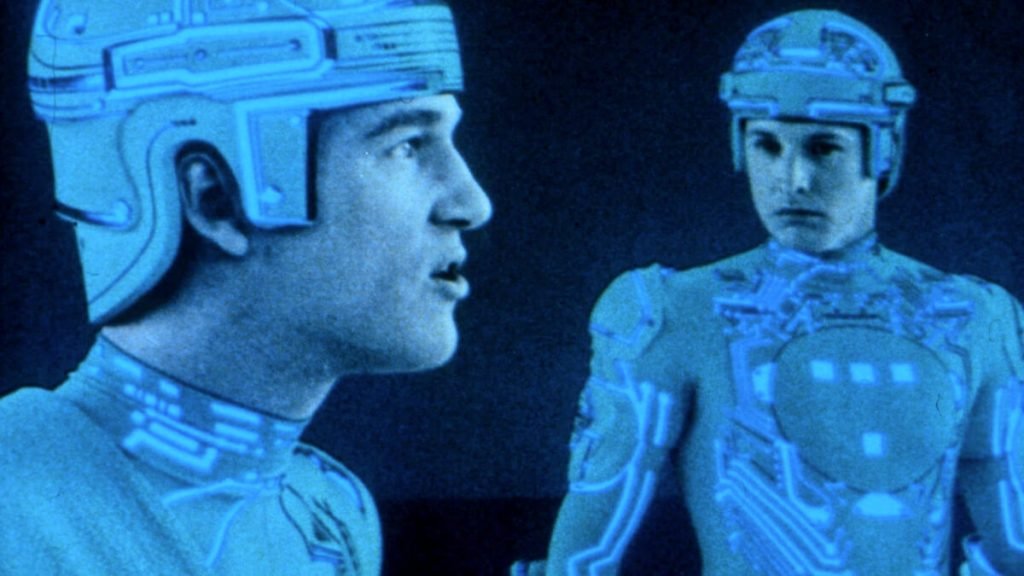
So this is where Harrison Ford enters the equation. As he recalls:
In May of 1980, I get a call from George Lucas. Who says ‘I’m messaging a script over to you this morning. As soon as it gets there, I need you to immediately read this script. Then – as soon as you’re done – I need you to call.
So the script arrives and it’s for ‘Raiders.’ I read it and it’s good. So I call George back and say ‘It’s good.’ And he then says ‘Would you be interested in playing Indy?’ I say that it looks like it would be a fun part to play.
George then says ‘ That’s great to hear. Because we start shooting in four weeks. Now I need you to meet with Steven Spielberg today and convince him that you’re the right guy to play Indy.’
Of course, given that Spielberg had been pushing for Ford to pay Indy ever since he had first seen that work-in-progress version of “The Empire Strikes Back” … Well, Harrison’s meeting with Steven was very, very short. And just a few weeks later, Spielberg, Lucas & Ford were all at the Port de la Pallice in La Rochelle. Where – on the very first day of shooting on “Raiders” (which – again – was June 23, 1980)– the scene that was shot was the one where that Nazi sub (the one that Indy had lashed himself to its periscope by using his bullwhip as a rope) was arriving at its secret base.
And all of this happened because Harrison immediately agreed to do “Raiders of the Lost Ark” when the part of Indy was first offered to him in mid-May of 1980.
Before “Star Wars” was “Star Wars”
So why such a quick yes? Well, you have to remember that “Empire Strikes Back” wouldn’t be released to theaters ‘til May 21, 1980. And no one knew at that time whether this sequel to the original “Star Wars” would do as well at the box office as “A New Hope” had back in 1977 (FYI: “Empire” would eventually sell over $500 million worth of tickets worldwide. Which is roughly two thirds of what the original “Star Wars” earned three years earlier).
More to the point, the four films that Harrison had shot right after “A New Hope” / prior to “Empire Strikes Back” (i.e., “Heroes” AND “Force 10 from Navarone” AND “Hanover Street” AND “The Frisco Kid”) had all under-performed at the box office. So to Ford’s way of thinking, taking on a role that Tom Selleck was no longer available to play – one that had the potential of spawning two sequels – seemed like a very smart thing to do. Especially after three years of cinematic stumbles.
By the way, whenever this topic ever comes up, Harrison Ford is very gracious. He always makes a point of saying that he’s grateful to have gotten this career opportunity. More to the point, that he still feels kind of bad that Tom Selleck never got the chance to play this part.
Tom Selleck After “Indiana Jones”
That said, we shouldn’t feel too bad for Tom Selleck. After all, the original “Magnum PI” proved to be a long running hit for CBS. And in an effort to smooth over any residual bad feelings that may have resulted from Tom being forced to give up “Raiders” back in May of 1980, Selleck was eventually allowed to create his own production company (i.e., T.W.S. Productions, Inc. As in Thomas William Selleck Productions). Which – after the fact – was then cut in on some of those “Magnum PI” -related revenue streams.
More to the point, while “Magnum PI” was on hiatus following its second year in production, Selleck flew off to Yugoslavia. Where he then shot his own Indiana Jones-esque film for theatrical release. Which was called “High Road to China” in the States, but – overseas – was promoted as “Raiders of the End of the World.”
FYI: Warner Bros. released “High Road to China” stateside 40 years ago this year. On March 18, 1983, to be exact. It didn’t do all that great at the box office. $28 million in ticket sales versus $15 million in production costs.
And over the years, there’s even been some talk of finding a way to maybe set things right here. By that I mean: Finally finding a way to officially fold Tom Selleck into the world of Indiana Jones.
Could Tom Selleck Work with Indiana Jones?
The way I hear it, between the time when “Indiana Jones and the Last Crusade” was theatrically released in May of 1989 and when “Indiana Jones and the Kingdom of the Crystal Skull” debuted in May of 2008, there were a number of ideas for Indiana Jones sequels tossed around. And from what I’ve been told, there was at least one treatment for a fourth Indiana Jones film written that proposed pairing up Harrison Ford & Tom Selleck. With the idea here being that Selleck was supposed to have played Ford’s brother.
Obviously that film was never made. And – no – I don’t know what state Indiana Jones’ brother was supposed to be named after.
This article is based on research for Looking at Lucasfilm “Episode 80”, published on June 29, 2023. Looking at Lucasfilm is part of the Jim Hill Media Podcast Network.
-

 History10 months ago
History10 months agoThe Evolution and History of Mickey’s ToonTown
-

 History11 months ago
History11 months agoUnpacking the History of the Pixar Place Hotel
-

 History11 months ago
History11 months agoFrom Birthday Wishes to Toontown Dreams: How Toontown Came to Be
-

 Film & Movies8 months ago
Film & Movies8 months agoHow Disney’s “Bambi” led to the creation of Smokey Bear
-

 News & Press Releases10 months ago
News & Press Releases10 months agoNew Updates and Exclusive Content from Jim Hill Media: Disney, Universal, and More
-

 Merchandise8 months ago
Merchandise8 months agoIntroducing “I Want That Too” – The Ultimate Disney Merchandise Podcast
-

 Theme Parks & Themed Entertainment3 months ago
Theme Parks & Themed Entertainment3 months agoDisney’s Forgotten Halloween Event: The Original Little Monsters on Main Street
-

 Film & Movies3 months ago
Film & Movies3 months agoHow “An American Tail” Led to Disney’s “Hocus Pocus”





